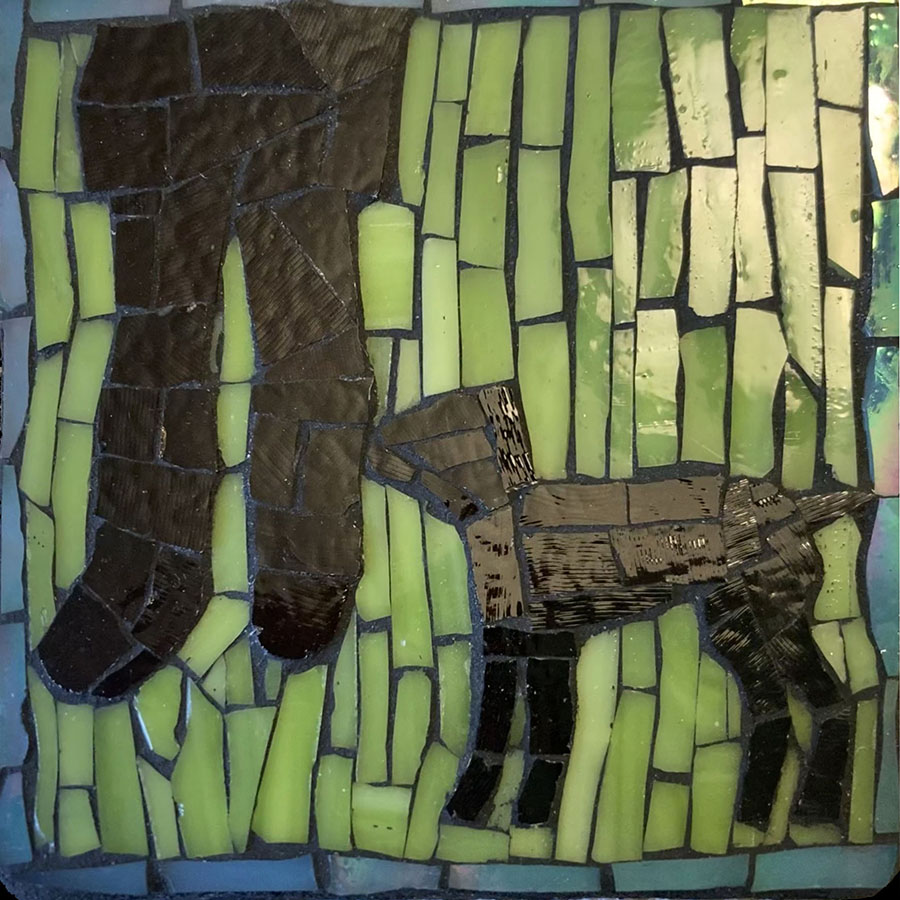Concrete stepping stones should be used as the bases for outdoor mosaics that will be walked on, and the stepping stones and thinset mortar that you would need to make those are available at most any building material store.
But what if you want to make small mosaic signs and mosaic plaques for your garden or porch?
Large porcelain floor tiles make great bases for these outdoor mosaics.
Ever since I started publishing updates on my mosaic door project that uses bamboo coasters for the bases of the small mosaics, I have been hoping that someone would email me an outdoor project that used “large” porcelain floor tiles as bases.
By “large” I mean anything 4 inches or larger.
Artist Cathy Reisfelt delivered.
Size and Detail

Cathy’s mosaics are also 4-inch in size, executed on the backs of some tiles she had left over from a home renovation project.
I prefer Cathy’s designs to mine as teaching examples because they use what I think of as an appropriate level of detail to render in that size of mosaic.
Cathy’s designs don’t have any filigree elements that would be particularly tedious, at least not when rendered in the long spindly pieces that are possible in when working in stained glass.
Cathy’s designs make efficient use of what detail there is. The results are iconic.
Pro Tip: The size and resolution of your mosaic is determined by the smallest detail in the image. Cut up some tile and try arranging it on a non-slip surface to form that smallest detail. If it’s too difficult, then you know that the image needs to be larger or that you need to simplify the details of the composition.
The size of a mosaic is determined by the size of the smallest detail.
If you arbitrarily limit yourself to a particular size for your compositions, then some compositions won’t be practical or even possible.
If your composition and level of detail are non-negotiable, then your option is to work in a larger size.
That is another selling point for using porcelain floor tiles as backers for outdoor mosaic plaques: There is a good selection of standard sizes to choose from: 4, 6, 8, 12, and 18 inches, and so you can get exactly the right size for your image to ensure that you can render a particular level of detail.

Porcelain Preferred
Use porcelain tiles instead of softer glazed ceramic tiles for more durable work. Porcelain is stronger than ceramic. Porcelain is also frost proof. Ceramic tiles aren’t and can be destroyed in a single freezing winter, particularly the soft glazed ceramic tile used in bathrooms.
A tile and grout sealer from the building material store will increase the life of your outdoor mosaic.
If you live in a harsh climate, clean and reseal your mosaics each fall. Bring vulnerable mosaics inside during the winter for longest life.

Thinset Mortar Preferred
Use thinset mortar instead of glue to mount your mosaic. Use a sheet of tape to pick up an entire mosaic design and press it into mortar spread on a backer.
Mosaic On the Back
If you are using a “large” porcelain floor tile as the backer for your outdoor mosaic, mount the mosaic on the back of the tile.
The finish or glazing on the front side will not grip the thinset as well as the back side, which has a slight texture embossed on it.
Large holes, valleys, and divots can be filled with thinset mortar three days before the mosaic is mounted. The thinset will need to cure for that time to fully “thin” or contract.
Improving Your Art

This is an indoor mosaic that Cathy made in a frame. I love the warm sunlight on the lion’s face and mane, and his facial expression is spot-on lion.
Here are two things that could have been done differently:
The top edge of the tree and the top edges of the mountains are exactly the same, and this is “distracting,” which is art-teacher speak for “not like real life.”
In real life, the tree would be shorter or taller or both in different places.
To break up this unlikely intersection of lines, the top of the tree could have been made jagged with slivers of mountain showing through in places.
We wouldn’t want to make the tree extend into the sky because there wouldn’t be sufficient contrast between the sky and tree colors.
The second change is a matter of focus.
The lions feet could have been made dark instead of light, which would make them draw less focus, which should be on the lion’s magnificent head.
Revising Mosaics?
The good think about laying up your mosaic on contact paper is that before you pick it up with mounting tape, you can let it sit for days or even weeks and slowly tweak it as you like.
You don’t have to commit to final mounting until you are sure, and you can revise it in major ways before you get to that step.



Leave a Reply